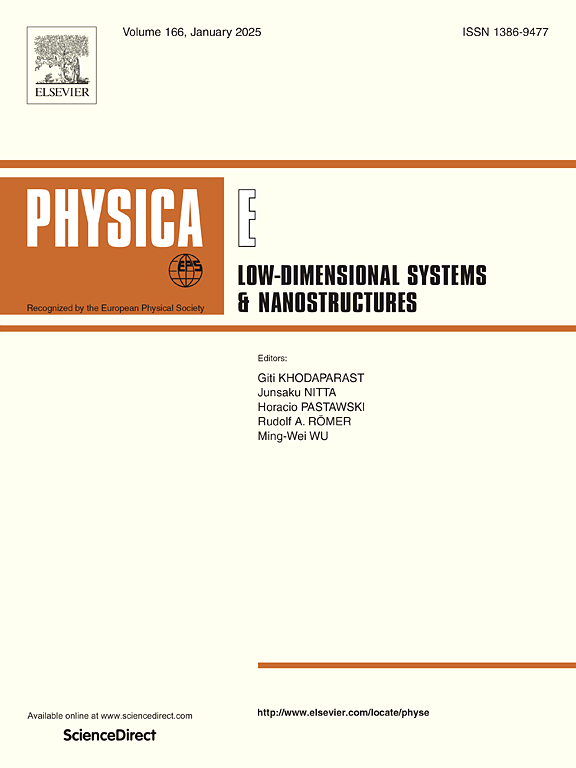氟化碳纳米管-绝缘体-金属二极管:第一原理计算预测
IF 2.9
3区 物理与天体物理
Q3 NANOSCIENCE & NANOTECHNOLOGY
Physica E-low-dimensional Systems & Nanostructures
Pub Date : 2024-10-30
DOI:10.1016/j.physe.2024.116133
引用次数: 0
摘要
通过使用 Atomistix 工具包进行量子输运计算,我们提出了基于碳纳米管 (CNT) 的二极管结构,该结构具有增强的二极管特性。我们的想法是使用带有氟化尖端的碳纳米管,并用绝缘(氧化锌)层将其与金属电极隔开。与由非氟化碳纳米管组成的二极管结构相比,该系统在电流大小和电流整流方面都显示出更好的工作特性。电流整流的增强与附加电压极性传输通道的形成有关。所提出的系统可用于制造基于碳纳米管的整流天线器件,从而提高太阳能转换效率。本文章由计算机程序翻译,如有差异,请以英文原文为准。

Fluorinated carbon nanotube-insulator–metal diodes: Predictions from first-principles calculations
Using quantum transport calculations with the Atomistix Toolkit, we propose carbon nanotube (CNT)-based diode structures featuring enhanced diode properties. The idea is to use a CNT with a fluorinated tip, which is separated from the metallic electrode by an insulating (ZnO) layer. This system shows better operational properties in terms of both current magnitude and current rectification compared to diode structures consisting of non-fluorinated CNTs. The enhanced current rectification is related to the formation of additional voltage-polarity-dependent transmission channels. The proposed system can be used to create CNT-based rectenna devices with enhanced solar conversion efficiency.
求助全文
通过发布文献求助,成功后即可免费获取论文全文。
去求助
来源期刊
CiteScore
7.30
自引率
6.10%
发文量
356
审稿时长
65 days
期刊介绍:
Physica E: Low-dimensional systems and nanostructures contains papers and invited review articles on the fundamental and applied aspects of physics in low-dimensional electron systems, in semiconductor heterostructures, oxide interfaces, quantum wells and superlattices, quantum wires and dots, novel quantum states of matter such as topological insulators, and Weyl semimetals.
Both theoretical and experimental contributions are invited. Topics suitable for publication in this journal include spin related phenomena, optical and transport properties, many-body effects, integer and fractional quantum Hall effects, quantum spin Hall effect, single electron effects and devices, Majorana fermions, and other novel phenomena.
Keywords:
• topological insulators/superconductors, majorana fermions, Wyel semimetals;
• quantum and neuromorphic computing/quantum information physics and devices based on low dimensional systems;
• layered superconductivity, low dimensional systems with superconducting proximity effect;
• 2D materials such as transition metal dichalcogenides;
• oxide heterostructures including ZnO, SrTiO3 etc;
• carbon nanostructures (graphene, carbon nanotubes, diamond NV center, etc.)
• quantum wells and superlattices;
• quantum Hall effect, quantum spin Hall effect, quantum anomalous Hall effect;
• optical- and phonons-related phenomena;
• magnetic-semiconductor structures;
• charge/spin-, magnon-, skyrmion-, Cooper pair- and majorana fermion- transport and tunneling;
• ultra-fast nonlinear optical phenomena;
• novel devices and applications (such as high performance sensor, solar cell, etc);
• novel growth and fabrication techniques for nanostructures

 求助内容:
求助内容: 应助结果提醒方式:
应助结果提醒方式:


